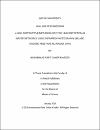A NON-DESTRUCTIVE METHODOLOGY FOR LEAK DETECTION IN WATER NETWORKS USING INFRARED PHOTOGRAPHY (IR) AND GROUND PENETRATING RADAR (GPR)
| Advisor | Al-Hawari, Alaa |
| Author | Khader, Mohammad Rafe |
| Available date | 2016-12-08T09:53:31Z |
| Publication Date | 2016 |
| Abstract | Two noninvasive and nondestructive methodologies for detecting leaks in water pipes were proposed and tested. The first method combines the use of Ground Penetrating Radar (GPR) for accurate determination of pipe location, followed by infrared (IR) thermographic imaging for determining the leak location. In IR thermography, four operating conditions (varying camera height and speed) were tested. Results were statistically analyzed using analysis of variance (ANOVA) and pairwise comparison methods. Several factors were found to affect the accuracy of the proposed methodology in predicting the leak location, namely, the characteristics of the studied surface (i.e. emissivity), the characteristics of the surrounding environment (i.e. ambient temperature and relative humidity), and the operating conditions of the IR camera (i.e. speed and height of the camera). In the case of low emissive surfaces, a slower camera speed would be required for the camera to be able to capture the thermal contrast at the real leak location. The results obtained in this study have also shown that under high ambient temperatures and high relative humidity conditions, a higher speed of the IR camera would reduce the impact of noise on the collected thermal contrast and therefore, would give better leak location prediction results. The field of view (FOV) is affected by the camera’s height from the surface. At lower heights, less area will be covered per frame; therefore, a more homogenous temperature distribution per frame will be obtained. Consequently, the contrast between the different frames will be higher and better leak predictions would be expected. The tested methodology proved the flexibility of the approach and the ability of accurately predicting the leak location under different conditions. In method two: the GPR alone was used to predict the existence and location of a leak in a water pipe. GPR data processing was performed based on the refined radargram, resulting in promising outcomes in the applicability of the method. |
| Sponsor | Qatar National Research Fund (QNRF) for funding this research (NPRP-5-165-2-055). |
| Language | en |
| Subject | Ground penetrating radar Infrared Thermal contrast thermogram water distribution network water leak Civil engineering Environmental engineering Water resources management |
| Type | Master Thesis |
| Department | Civil Engineering |
Files in this item
This item appears in the following Collection(s)
-
Civil Engineering [48 items ]


